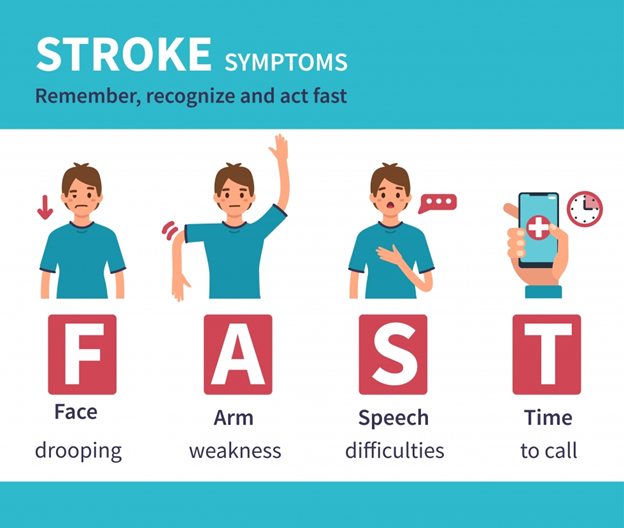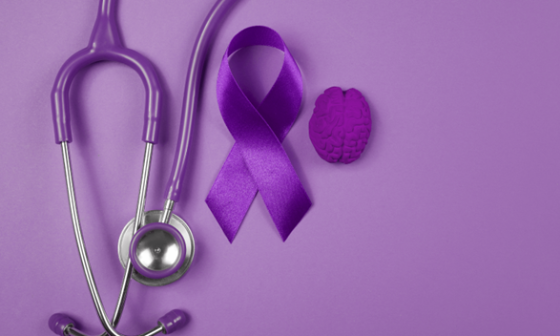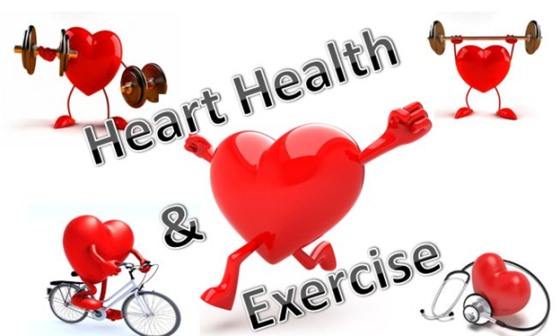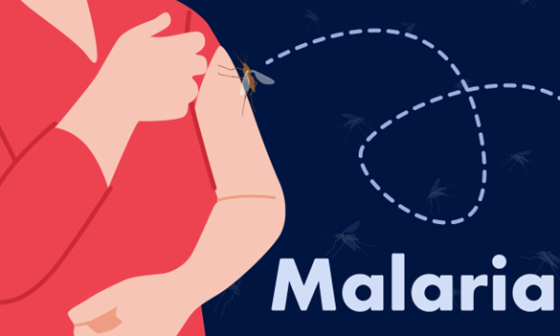Introduction
Globally, stroke is one of the main causes of mortality, dementia, and disability. It happens when there is an interruption in blood flow to a portion of the brain, depriving brain cells of nutrition and oxygen.
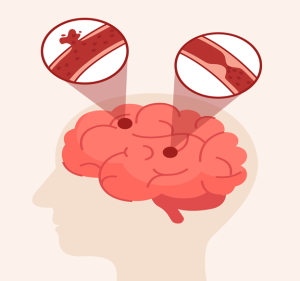
Source:Synappse Health
According to a research paper on stroke in Africa in Nature Reviews Neurology, it was reported that stroke had an annual incidence rate of up to 316 per 100,000 in Africa, a frequency of up to 1,460 per 100,000, and a 3-year death rate of more than 80%, according to data released within the last ten years. Furthermore, a large number of Africans experience a stroke between the ages of their fourth and sixth decade of life, which can have a major impact on the victim, their family, and society.
This article clarifies stroke and its types, including its risk factors, warning indicators, and the necessity of obtaining emergency care.
Types of Stroke
Two primary types of stroke exist: Ischaemic and Hemorrhagic types
Ischaemic stroke:
About 85% of all strokes are of the ischemic kind, which is the most prevalent. It happens when a blood clot obstructs a brain-supplying artery.
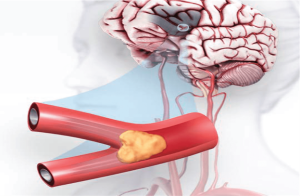
Source: American Stroke Association
Hemorrhagic stroke:
This occurs when a cerebral artery that has been compromised leaks or bursts, resulting in bleeding inside the brain tissue.
Transient Ischaemic Attack (TIA, Mini Stroke)
A mini-stroke happens when blood flow to a portion of the brain is momentarily disrupted. The symptoms of this transient blockage are similar to those of a stroke, although they usually subside fully in a day or two after the disruption of brain activity.
Stroke Risk Factors
Several variables can raise the chances of having a stroke, such as:
- High Blood Pressure: Uncontrolled High BP is a major risk factor for stroke.
- High LDL: Low-density lipoprotein (“bad”) cholesterol levels that are high can increase a person’s chance of having a stroke. High LDL predisposes to plaque accumulation in arteries, which can form clots that block vessels.
- A previous history of Transient ischaemic attack
- Diabetes: Uncontrolled diabetes increases the risk of blood clots and can damage blood vessels.
- Smoking: Smoking raises the risk of blood clots as this doubles the risk for ischaemic stroke. Also, smoking can destroy blood vessels increasing a smoker’s risk of stroke.
- Heart Disease: Atrial fibrillation; a condition that causes erratic heartbeat raises the possibility of blood clots that could reach the brain and result in a stroke. Structural abnormalities like damaged heart valves (valvular heart disease) can cause long-term (chronic) heart damage.
- Obesity: Having a high body mass index or being fat raises the risk of clots and then stroke.
- Family History: An individual is at more risk if a close family relative has experienced a stroke.
- Older age: The risk of stroke more than doubles for every ten years of life after the age of fifty-five.
- Race: Compared to White people, African Americans and Africans have a significantly higher risk of stroke-related death and disability. This is partially due to the higher prevalence of high blood pressure among them.
- Gender: Men are more likely than women to have a stroke, but more women than men die from strokes.
- Others: birth control pills, high red cell count,
Identifying the Stroke Warning Signs
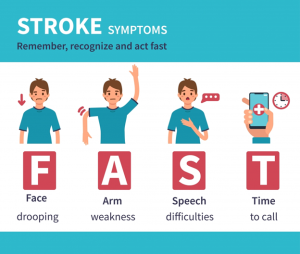
Source: Niagara Therapy
When it comes to stroke, acting FAST (Face, Arms, Speech, Time) is essential.
An individual, a bystander, or a family member, must keep in mind the following important warning signs:
Facial drooping
Is the person experiencing drooping or numbness in their face? The bystander should request a smile from the person. Does the face appear uneven on one side?
Arm weakness
Is the person able to extend both arms to the same level? Does one arm sag to the side?
Speech difficulty
Is the speaker’s speech unclear or slurred? Request that they repeat a short sentence. Do they sound funny when they speak, or are they unable to do so?
Time to call emergency services
Call emergency services immediately if you see any of the below indicators. Seek medical assistance as soon as possible, even if the symptoms appear minor or pass quickly. In the treatment of stroke, time is crucial.
- Suddenly losing feeling in one or more extremities, such as the face, arm, or leg
- Abrupt disorientation, difficulty understanding or speaking
- Unexpected visual problems in one or both eyes
- Abrupt difficulties walking, lightheadedness, or imbalance or disarray
- Sudden, intense headache without apparent cause
The Value of Early Intervention
Reducing brain damage and enhancing stroke survivors’ chances of recovery depend on prompt diagnosis and treatment. To restore blood flow to the brain, medical personnel can operate or give clot-busting drugs.
Stroke Prevention
Although certain risk factors such as age and family history are unmodifiable, a person can greatly lower their risk of stroke by leading a healthy lifestyle and modifying their habits. The following suggestions have proven to be beneficial:
Keep Up a Nutritional Diet: Reduce your intake of added sugars, salt, and bad fats. Make sure your diet is well-balanced and full of nutritious grains, fruits, and veggies.
Handle Blood Pressure: Individuals with family histories of hypertension must keep an eye on their blood pressure. Additionally, people who have been diagnosed with hypertension must know their blood pressure readings regularly and collaborate with their physicians to manage it.
Physical Activity: Maintaining an active lifestyle is a key way to preventing certain risk factors for stroke like obesity and hypertension which ultimately protects you from getting stroke. To maintain an active life, you should get at least 150 minutes a week of moderate-to-intense activity or 75 minutes of vigorous exercise.
Keep a Healthy Weight: Weight maintenance and reduction will help lower the risk of stroke, especially if you are overweight or obese.
Handle Diabetes Well: If you have the disease, take prescribed medicine, diet, and exercise to carefully control blood sugar levels.
Give Up Smoking: One of the main risk factors for stroke is smoking. One of the best things smokers can do for their general health is to stop smoking.
Conclusion
A stroke is a dangerous medical situation. Recognizing the warning symptoms and getting help right away will greatly increase the chances of making a full recovery.
At Wellahealth, we’re dedicated to raising awareness of stroke and giving you the tools you need to take control of your health. For additional details on stroke prevention, management of risk factors, and modification of lifestyle, contact us at https://www.wellahealth.com/ today!
Dr. Ifeoma M. Uduh, Dr. John Afam
